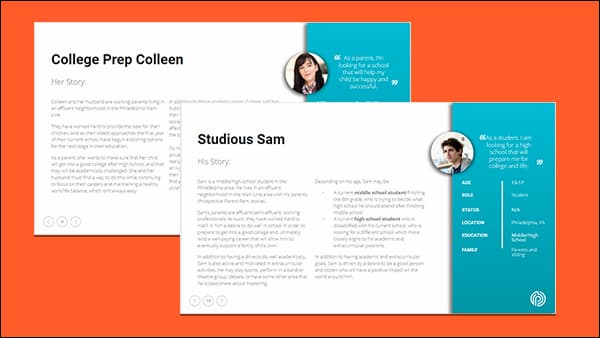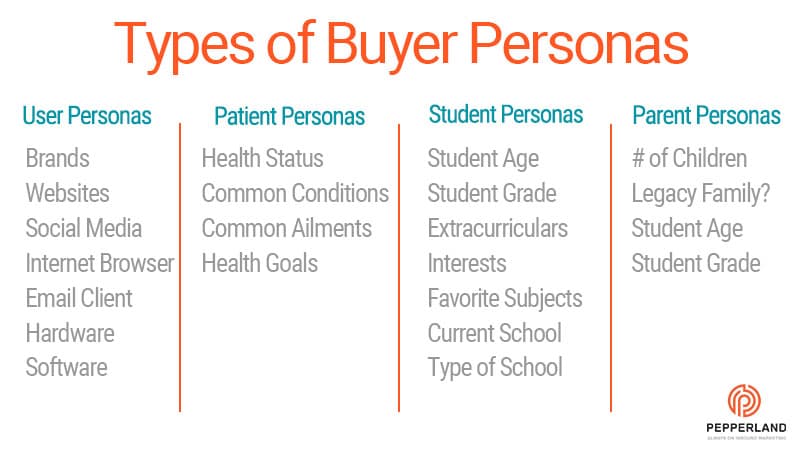Written By:
Tim Stobierski
An accurate buyer persona is a hallmark of a high-quality inbound marketing campaign. Without one, it will be difficult—if not outright impossible—for you to know whether you are creating content that resonates with the type of person you are trying to attract to your website.
If you’re looking for a buyer persona template that you can use to start building your persona, you’re in luck.
Download our Buyer Persona Template and Toolkit, and continue reading to learn more about the different kinds of information you should aim to capture in your buyer persona.
What is a buyer persona?
A buyer persona is a semi-fictional representation of your ideal customer, client, or user, which is based on a mix of market research, interviews, and data analysis. They are also sometimes called buyer archetypes or buyer profiles.
Buyer personas typically capture your ideal customer’s demographics, motivations and priorities, challenges, common behaviors, and the questions that they ask as they progress along the buyer’s journey.
In the marketing world, personas typically form the base of an organization’s content strategy. The more thoroughly a business understands who their ideal customer is and the questions that they have, the better they can tailor their content efforts to speak to those individuals and usher them through the buyer’s journey.
But personas do have multiple uses outside of marketing. They can also be used to inform user experience and product design considerations, and more.
The Essential Elements of a Buyer Persona

The buyer persona that you create to represent your ideal customer or client should ultimately be tailored to include information that speaks to the unique needs of your business and industry.
Need help creating a persona? Download our template!
That being said, at their heart, all buyer personas should include certain baseline information. That’s why all buyer persona templates include fields for data like:
- Name: This is how you’ll refer to your persona internally, so it’s important that you choose something that will be easy to remember. We’ll often go for alliteration to help ourselves (and our clients) easily remember their personas.
- Photo: This photo will be used to visually represent your persona internally.
- Description: This is a brief, one to two sentence description that summarizes who your persona is.
- Roles: What kind of job does your persona have? Depending on your business, this field might include information about the roles they play in their working life, their family life, their social life, or any relevant combination thereof.
- Goals: What does your persona hope to accomplish? What are their motivations? As with the Roles category above, this should account for personal, professional, and social goals.
- Challenges: What are the challenges that this person faces when they are trying to fulfill the roles or goals outlined above?
- Demographics: How old is your persona? What is their average income range? Do they tend to work in a particular industry or carry a certain job title? What is their average level of education? Do they live in a particular location? Etc.
- Story: This is a more detailed description of who your persona is and what their buyer’s journey looks like. It often takes the form of a narrative that explains why your persona needs or wants your product, service, or solution. At what moment did they decide to make a change and embark on this journey? Where does your persona go to find the information they use to make their decisions? What do they like to do in their free time? What are their greatest fears?
Based off of the information outlined above, you should be able to go far in creating a baseline persona for your business. That being said, it’s important that you take the time to tailor your persona to the specific needs of your industry or niche.
Tailoring Your Persona to your Niche
As mentioned above, depending on the industry that you work in and the type of product, service, or experience that you sell and promote, you may need to adjust your persona template by adding in other relevant fields. We explore some of the common types of buyer personas, and the specific information they should include, below.

1. User Personas
The term user persona is typically used to refer to a buyer persona that is specifically tailored for user experience (UX) purposes. They are predominantly leveraged by mobile app, software, or web development companies, though they can also be leveraged for physical products.
In addition to the information outlined above, user personas will often include fields for:
- Favorite Brands
- Favorite Websites
- Social Media Preferences
- Preferred Internet Browser
- Preferred Email Client
- Devices (desktop, mobile, other hardware)
Recommended Resources:
2. Student Personas
Student personas are leveraged by educational institutions, and represent the ideal student that that particular institution is trying to attract. This can refer to students at any level, such as Elementary & Middle School, High School, College, or Postgraduate, and so on. It may also include institutions responsible for accreditation and licensing.
In addition to the information outlined above, student personas will often include fields for:
- Student Age
- Student Grade Applying For
- Extracurricular Activities and Interests
- Favorite Subjects
- Current or Previous School (Name of School)
- Type of Current or Previous School (Public, Private, Catholic, etc.)
Recommended Resources:
For more information about creating student personas and leveraging inbound marketing in education, see:
How To Use Student Personas To Increase Applications (Plus Free Toolkit)
Student Persona Interview Guide: 40 Questions to Ask
3 Emerging Student Personas You Might Be Overlooking
Why You Should Market Your School Through Inbound Marketing
3. Parent Personas
Parent personas are also leveraged by educational institutions—specifically those where a parent will be the primary decision maker for the student. This means that they are more likely to relate to parents of elementary-, middle-, and high-school-aged students than they are to relate to parents of college-aged students.
In addition to the information outlined above, parent personas will often include fields for:
- Number of Children
- Legacy Family Status
- Student Age
- Student Grade Applying For
Recommended Resources:
4. Client or Patron Personas
Client personas (also called patron personas) are typically leveraged by consumer-oriented businesses such as salons, restaurants, clothing stores, boutiques, etc. They represent the ideal patron that the business would like to attract through their marketing efforts.
In addition to the information outlined above, client or patron personas will often include fields for:
- Favorite Brands
- Personal Style
- Follows on Social Media
Recommended Resources:
5. Patient Personas
A patient persona is typically leveraged by organizations and individuals who work in a healthcare setting (such as a doctor’s office, clinic, hospital, insurance company, etc.) and is used to represent the typical patient that that organization sees and treats.
In addition to the information outlined above, patient personas will often include fields for:
- Average Health Status
- Common Conditions and Ailments
- Common Health Goals
- Ways Your Practice or Facility Helps
- What the Persona Seeks from a Healthcare Provider
Free Buyer Persona Templates
Looking for a free buyer persona template to guide your persona creation process? Below are a handful of trusted resources that we recommend you start with:
- HubSpot’s Make My Persona Tool
- Pepperland’s Buyer Persona Template & Toolkit
- Pepperland’s Student & Parent Persona Toolkit
Finding the Right Persona for Your Needs
While it’s of course important for your persona to be as accurate as possible, it’s also important for you to remember that a persona is a living document that can—and often should—change over time as you learn more about your ideal customer and what motivates them. They don’t need to be perfect right off the bat; in fact, that will almost never be the case.
This is why when we create personas for our clients, we tend to call the first pass a provisional persona. Its purpose is to act as a prototype against which we test our assumptions and make adjustments until we are confident that the persona accurately represents the ideal buyer.
Not sure whether you should bring in an agency to create your personas or start the process in house? Agencies tend to have the benefit of various research tools and databases, as well as years or decades of experience in creating personas for numerous businesses across multiple industries. For that reason, a persona created by an agency will almost always be more robust than a persona that you create in house.
That being said, we’ll almost always recommend that a company starts the process themselves, because even if you were to bring in an agency, they will start their process by asking you for your opinions on who your persona is. Having even a paragraph of text that speaks to who you believe your ideal buyer is will save you and any agency you work with valuable time and resources that can be used elsewhere.
Are you ready to get started brainstorming your first persona? Download our Persona Template and Toolkit and start understanding your ideal customer so that you create a content marketing strategy and marketing funnel that will convert.








